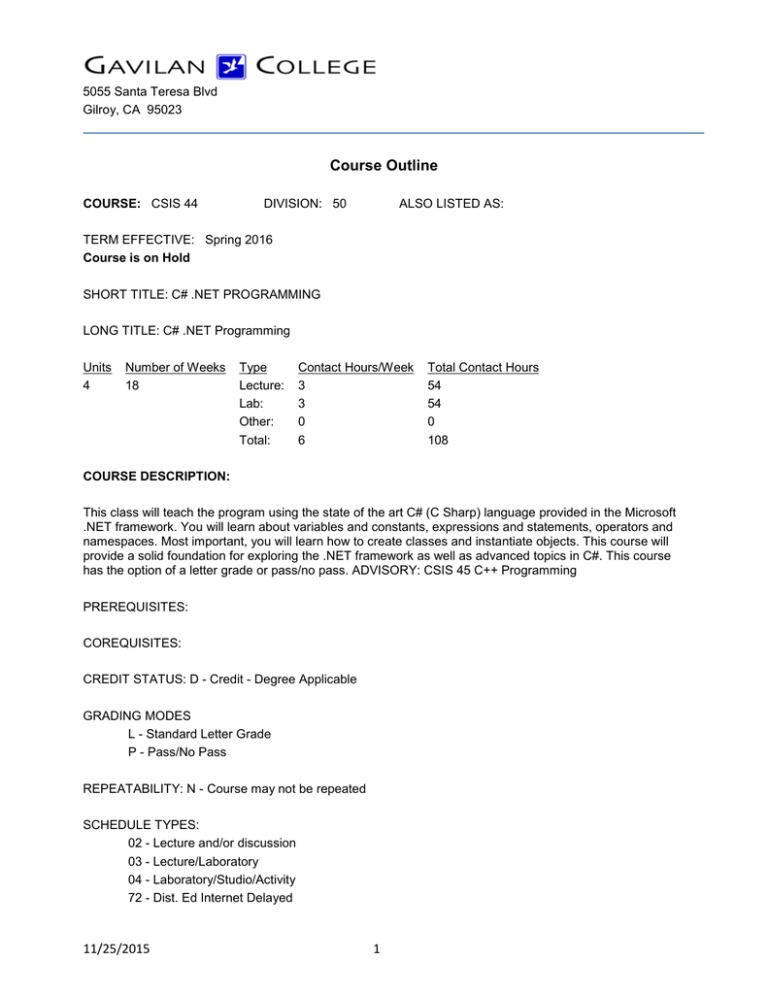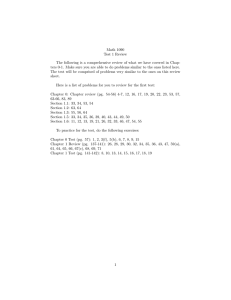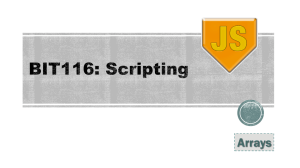Course Outline - Gavilan College
advertisement

5055 Santa Teresa Blvd Gilroy, CA 95023 Course Outline COURSE: CSIS 44 DIVISION: 50 ALSO LISTED AS: TERM EFFECTIVE: Spring 2016 Course is on Hold SHORT TITLE: C# .NET PROGRAMMING LONG TITLE: C# .NET Programming Units 4 Number of Weeks 18 Type Lecture: Lab: Other: Total: Contact Hours/Week 3 3 0 6 Total Contact Hours 54 54 0 108 COURSE DESCRIPTION: This class will teach the program using the state of the art C# (C Sharp) language provided in the Microsoft .NET framework. You will learn about variables and constants, expressions and statements, operators and namespaces. Most important, you will learn how to create classes and instantiate objects. This course will provide a solid foundation for exploring the .NET framework as well as advanced topics in C#. This course has the option of a letter grade or pass/no pass. ADVISORY: CSIS 45 C++ Programming PREREQUISITES: COREQUISITES: CREDIT STATUS: D - Credit - Degree Applicable GRADING MODES L - Standard Letter Grade P - Pass/No Pass REPEATABILITY: N - Course may not be repeated SCHEDULE TYPES: 02 - Lecture and/or discussion 03 - Lecture/Laboratory 04 - Laboratory/Studio/Activity 72 - Dist. Ed Internet Delayed 11/25/2015 1 STUDENT LEARNING OUTCOMES: 1. Create C# programs and use .NET system. ILO: 3,2,7 Measure: Homework, exercises. 2. Use selection and repetition commands. ILO 3,2,7 Measure: Homework, exercises. 3. Design C# programs. ILO: 1,3,2 Measure: Projects, homework 4. Create and use classes and inheritance. ILO: 3,7,2 Measure: Programs, exercises. CONTENT, STUDENT PERFORMANCE OBJECTIVES, OUT-OF-CLASS ASSIGNMENTS Inactive Course: 11/23/2015 Students repeating this class will learn new C# commands and Windows capabilities, and will expand previous knowledge. Both the C# language and the Windows are changing once a year. WEEK HOURS CONTENT: 1-2 6/6 Lecture: Introduction to C# and .NET technology. Object-oriented programming and the .NET system. Compiling and executing C# programs. Types and declaring variables. Arithmetic operations and formatting output. Input and named constants. Homework and lab work: Read the chapters for the lecture material and do the exercises at the end of the chapter. Enter, compile, and debug the chapter sample programs. Write new programs from the end-of-chapter exercises. 3-4 6/6 Lecture: Using methods with several types of arguments. Writing methods that have no arguments and return no values. Writing methods that have arguments and return values. Avoiding ambiguous methods and over loading methods. Homework and lab work: Read the chapters for the lecture material and do the exercises at the end of the chapter. Write C# programs that have no arguments and return no values. Write C# programs that have arguments and return values. Write C# programs that use ref and out parameters with methods. 5-6 6/6 Lecture: 11/25/2015 2 Creating and using classes. Understanding class concepts. Declaring and instantiating objects. Using public fields and private methods. Understanding this reference and constructor methods. Overloading constructors and passing parameters to constructors. Homework and lab work: Read the chapters for the lecture material and do the exercises at the end of the chapter. Write programs that use public fields and private methods. Write programs that use this reference and constructor methods. Write programs that overload constructors and pass parameters to constructors. 7-8 6/6 Lecture: Selection and repetition. Making decisions using the if-else statement. Making decisions using the switch statement. Making decisions using the conditional operator. Using while, for and do loops. Homework and lab work: Read the chapters for the lecture material and do the exercises at the end of the chapter. Write programs that use the if-else statements. Write programs that use switch statements. Write programs that use while, for and do loops. 9-10 6/6 Lecture: Using arrays and array methods. Declaring and initializing arrays. Using array subscripts and length field. Using foreach to process arrays. Searching and sorting arrays. Writing array methods and using array objects. Homework and lab work: Read the chapters for the lecture material and do the exercises at the end of the chapter. Write programs that declare and initialize arrays. Write programs that use subscripts and foreach to process arrays. Write programs that search and sort arrays. Write programs that use array methods and array objects. 11-12 6/6 Lecture: Introduction to inheritance and understanding the concept of inheritance. Extending classes and using the protected access 11/25/2015 3 specifier. Using object classes and methods. Working with superclasses and constructors. Creating and using abstract classes and class interfaces. Homework and lab work: Read the chapters for the lecture material and do the exercises at the end of the chapter. Write programs that use inheritance. Write programs that extend classes and use the protected access specifier. Write programs that use superclasses and contructors. Write programs that use abstract classes and class interfaces. 13-14 6/6 Lecture: Introduction to inheritance and understanding the concept of inheritance. Extending classes and using the protected access specifier. Using object classes and methods. Working with superclasses and constructors. Creating and using abstract classes and class interfaces. Homework and lab work: Read the chapters for the lecture material and do the exercises at the end of the chapter. Write programs that use inheritance. Write programs that extend classes and use the protected access specifier. Write programs that use superclasses and constructors. Write programs that use abstract classes and class interfaces. 15-16 6/6 Lecture: Understanding and using exceptions. Understanding traditional error-handling methods. Using system provided exceptions and purposely generating a system exception. Writing, throwing and catching programmer created exceptions. Using finally black and tracing exceptions. Homework and lab work: Read the chapters for the lecture material and do the exercises at the end of the chapter. Write programs that use language provided exceptions. Write programs that generate a normal exception. Write programs that write, throw and catch programmer created exceptions. Write programs that use finally blocks and trace 11/25/2015 4 exceptions. 17-18 6/6 Lecture: Using GUI objects and Visual Studio IDE. Creating forms and form objects. Using controls such as labels, checkboxes, radiobuttons, and lists. Final exam and final projects. Homework and lab work: Read the chapters for the lecture material and do the exercises at the end of the chapter. Write programs that use GUI objects and Visual Studio IDE. Write programs that create forms and form objects. Write programs that process labels, checkboxes, radiobuttons and lists. ASSIGNMENTS: See content section of course outline. METHODS OF INSTRUCTION: Lecture, computer demonstrations, C# program examples, and web searches. METHODS OF EVALUATION: The types of writing assignments required: Written homework The problem-solving assignments required: Homework problems Quizzes Exams The types of skill demonstrations required: Class performance Performance exams The types of objective examinations used in the course: Multiple choice True/false Matching items Completion Other category: None The basis for assigning students grades in the course: Writing assignments: 10% - 30% Problem-solving demonstrations: 20% - 40% Skill demonstrations: 40% - 80% Objective examinations: 10% - 20% Other methods of evaluation: 0% - 0% REPRESENTATIVE TEXTBOOKS: Required: Bradley and Millspaugh, Programming in Visual C#, McGraw Hill, 2009 11/25/2015 5 ISBN: 0070172811 Reading Level of Text: 12, Verified by: dvt ARTICULATION and CERTIFICATE INFORMATION Associate Degree: CSU GE: IGETC: CSU TRANSFER: Transferable CSU, effective 200630 UC TRANSFER: Not Transferable SUPPLEMENTAL DATA: Basic Skills: N Classification: Y Noncredit Category: Y Cooperative Education: Program Status: 1 Program Applicable Special Class Status: N CAN: CAN Sequence: CSU Crosswalk Course Department: CSIS CSU Crosswalk Course Number: 44 Prior to College Level: Y Non Credit Enhanced Funding: N Funding Agency Code: Y In-Service: N Occupational Course: B Maximum Hours: Minimum Hours: Course Control Number: CCC000208967 Sports/Physical Education Course: N Taxonomy of Program: 070710 11/25/2015 6

